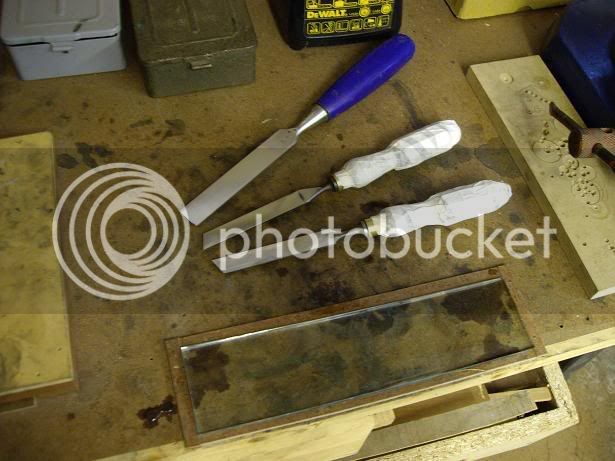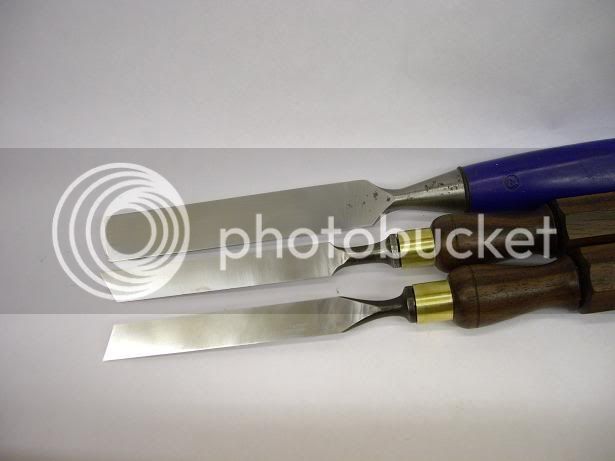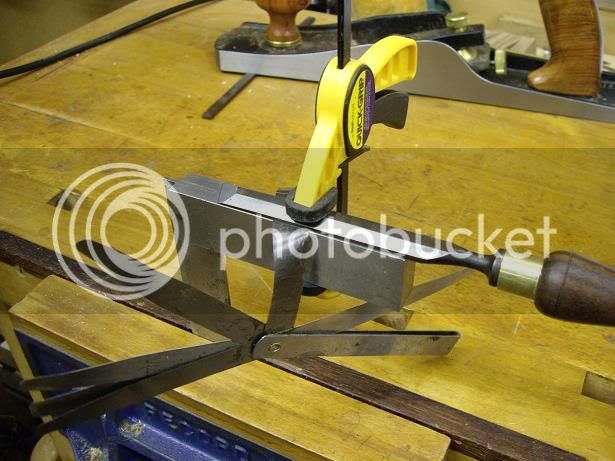woodbloke
Established Member
I wasn't really happy with the 'Scary sharp' method of lapping a chisel back that I was playing around with the other day with the Blue chip...there was an undesirable element of 'drubbing' at the front as I was holding by the handle and using a full width piece of w/d. This afternoon I bought a much smaller piece of 6mm float glass about the width of a bit of w/d paper but only 60mm wide, which is about 2/3rds the length of a chisel blade:

In this first pic above you can see the three chisels I was messing around with. The middle skew and the Blue Chip have been flattened on the first paper, 150g which was stuck to the glass using some spray on adhesive. The skew nearest the camera is as I was using it...a pretty patchy, sort of mottled back and not really flat. The next pic shows the finished backs having been polished to 1200g, which is the finest paper I could find in town this afternoon:

What is absolutely essential is that the handle is never touched in case it's raised, even once will be disaster! The technique, which is borrowed from MrC (David...many thanks ) is to move the chisel back and forth on the stone so that the edge hangs off the far edge for about 50% of the time, and pressure is always applied directly onto the blade back. The result is a really excellent polish on the backs but even better, if this technique is strictly adhered to:
) is to move the chisel back and forth on the stone so that the edge hangs off the far edge for about 50% of the time, and pressure is always applied directly onto the blade back. The result is a really excellent polish on the backs but even better, if this technique is strictly adhered to:

.....you will achieve a hollow back to the blade. The chisel is being held by the lightest of pressure using the little clamp (freebie from F&C) so that there are two points of contact on the back of the square and as you can see, a feeler gauge can be inserted . Total cost to do this was about £4, so not bad for some lapped chisel backs...LN's next
. Total cost to do this was about £4, so not bad for some lapped chisel backs...LN's next  - Rob
- Rob

In this first pic above you can see the three chisels I was messing around with. The middle skew and the Blue Chip have been flattened on the first paper, 150g which was stuck to the glass using some spray on adhesive. The skew nearest the camera is as I was using it...a pretty patchy, sort of mottled back and not really flat. The next pic shows the finished backs having been polished to 1200g, which is the finest paper I could find in town this afternoon:

What is absolutely essential is that the handle is never touched in case it's raised, even once will be disaster! The technique, which is borrowed from MrC (David...many thanks

.....you will achieve a hollow back to the blade. The chisel is being held by the lightest of pressure using the little clamp (freebie from F&C) so that there are two points of contact on the back of the square and as you can see, a feeler gauge can be inserted
































